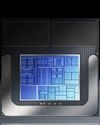
Crucial’s BX500 internal SSD offers a lot of capacity for not so much cash, along with great everyday, real-world performance. Most users will be perfectly happy with this QLC drive, as long as they don’t bang on it too hard—as in writing large amounts of data in a short period of time, or filling the drive to point where it runs out of NAND to treat as cache. At that point, write performance drops to around the hard-drive level.
DESIGN AND PRICE
The BX500 is a 7-mm-thick, super-light, 2.5-inch SATA 6Gbps SSD. It comes in several flavors: The 2TB capacity we tested (currently $200 on Amazon), 1TB ($90 on Amazon [go.pcworld.com/90am]) , 480GB ($55 on Amazon [go.pcworld.com/55am]), and 240GB ($39.95 on Amazon [go. pcworld.com/39am]). That’s about as cheap as you’ll find, not to mention a rather interesting mix of capacities.
Normally you’ll see 250GB and 500GB drives sold in product lines that feature 1TB and 2TB models, or conversely, 980GB and 1920GB with 240GB and 480GB drives. This is due to the percentage of NAND used for overprovisioning (allotting spare cells as replacements). Crucial obviously feels that the lower-capacity BX500s require more, which might have something to do with intelligent caching. Or not.
The BX500 employs a Silicon Motion SM2259XT controller. The four NAND chips inside our 2TB test model bore the OBY22NX894 marking. I found no reference to those NAND part numbers online; however, there were four chips on the rather small PC board inside the unit. The large drop in performance after running out of secondary cache during our long 450GB write test strongly suggests that it’s QLC or quad-level cell/4-bit (16 voltage levels).
Denne historien er fra June 2021-utgaven av PCWorld.
Start din 7-dagers gratis prøveperiode på Magzter GOLD for å få tilgang til tusenvis av utvalgte premiumhistorier og 9000+ magasiner og aviser.
Allerede abonnent ? Logg på
Denne historien er fra June 2021-utgaven av PCWorld.
Start din 7-dagers gratis prøveperiode på Magzter GOLD for å få tilgang til tusenvis av utvalgte premiumhistorier og 9000+ magasiner og aviser.
Allerede abonnent? Logg på

Private Internet Access: A low-price, high-value VPN for everyone
This veteran VPN shows it can still hang with the best.

Hands-on: Kensington's first Thunderbolt 5 dock is built for the future
Thunderbolt 5 is here...but you'll need more than just this well-built Kensington dock to take advantage of it.

Tested: Intel's Lunar Lake chip wants you to forget Qualcomm laptops exist
Great battery life, mediocre performance, surprisingly decent gaming: That is how Intel's Lunar Lake chip stacks up.

7 laptop habits that coax the most out of your battery
Don't send your laptop into an early grave.

WordPad is gone from Windows 11. Here's how to bring it back
With the arrival of Windows 11 version 24H2, WordPad is officially gone. Want to keep using it? You're in luck.

Hackers know your social security number. Here's how to stay safe
Thanks to a multitude of data leaks, your most sensitive information is now easily accessible to the world.

20 insanely useful Windows 11 keyboard shortcuts I use every day
After so many years, I'm still discovering new keyboard shortcuts.

WHAT THE HECK IS AN NPU, ANYWAY? HERE'S AN EXPLAINER ON AI CHIPS
ALL PCS WILL SOON HAVE NEURAL PROCESSING UNITS. HERE'S WHAT THAT MEANS FOR YOU IN SIMPLE TERMS.

WINDOWS 11'S 2024 UPDAATE: 5 BIG CHANGES I REALLY LIKE (AND MORE)
WINDOWS 11'S ANNUAL UPDATE IS ROLLING OUT OVER THE NEXT FEW WEEKS.

Hackers are using AI-generated code for malware attacks
Two separate attacks have been spotted using code that was probably written by artificial intelligence.